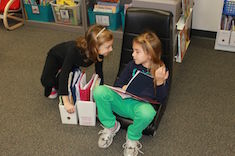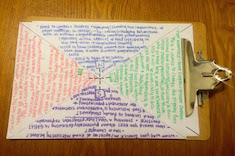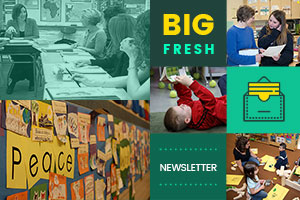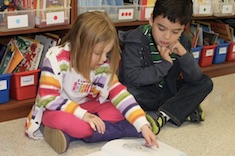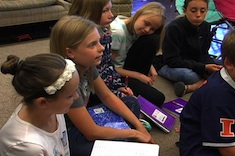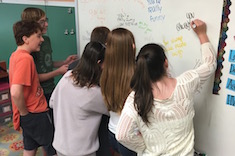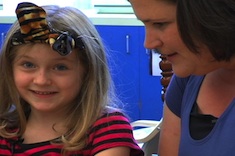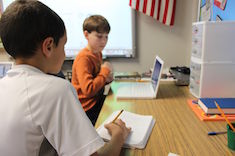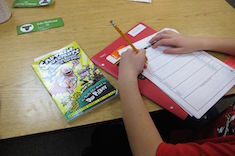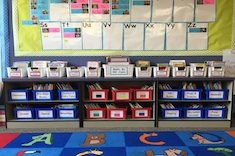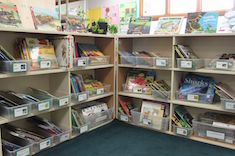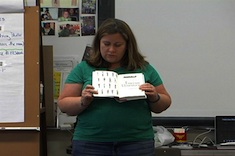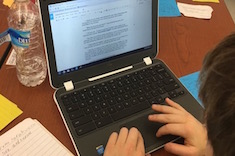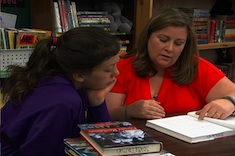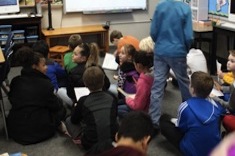Library
Choice Literacy Articles & Videos
The Choice Literacy library contains over 3,000 articles and 900 videos from 150+ contributors. Classic Classroom and Literacy Leadership subscribers have access to the entire library. Content is updated continuously, with five to six new features published each week.
Latest Content
Independent Project Hiccups
Tara Barnett and Kate Mills conclude their series on independent projects with advice on how to handle issues that often crop up as students design and work through writing their projects.
Improving Turn-and-Talks
Melanie Meehan shares questions and reflection prompts to make the turn-and-talk strategy more effective.
Talk Guide
Gigi McAllister presents a guide to her fourth-grade students to improve talk in reading trios.
Compass Points and Empathy
Andrea Smith uses the “compass points” strategy to provoke better whole-class discussions and reflection during read alouds.
The Big Fresh May 5, 2018 The Space Between
We consider the boundaries between home and school in this week’s Big Fresh.
My World Maps
Creating “world” maps is a great way to explore the territories beyond school that matter most to everyone in your classroom. Suzy Kaback explains how to create them with students early in the year as a way to get to know them as learners and community members.
One Child, Many Stories
Asking the right questions of family members can get you far more valuable information than anything from an assessment, especially when you are dealing with English language learners. Stella Villalba explains why initial meetings with new families are crucial.
Authentic Reading in Kindergarten
Dana Murphy realizes the best way to introduce students to reading in kindergarten is to apply the principles that work at home with her own children.
Group Meeting: Sharing Resources for Animal Study
Katherine Sokolowski helps her fifth-grade students expand their territory for their animal research projects by sharing information sources and peer connections.
The Big Fresh April 28, 2018 Doing Enough
We consider how to close out the year strong in this week’s Big Fresh.
Summer Reading
Bitsy Parks reflects upon her own not-so-successful experiences as a parent in getting her four children to read during the summer months. She uses these parenting lessons to help students take the initiative for summer reading by writing down commitments and goals in her first-grade classroom.
Spreading Love with Compliments
Tara Barnett and Kate Mills close out the year in their eighth-grade classroom with a compliments activity.
The Big Fresh April 21, 2018 Big Dog
We consider what makes literacy instruction authentic in this week’s Big Fresh.
Looking Forward with Students
Melanie Meehan uses reflective questions and video to build a library of materials at the end of the year to use with next year's class.
First-Grade Conference: Reading with Feeling
In this week’s video, Katrina Edwards confers with first grader Ellie. She helps Ellie read more fluently and with expression by transferring her feelings to those of characters.
Using Tech to Find Authentic Audiences for Student Writing
Matt Renwick discovers technology provides many authentic audiences for student writing.
Puppy Chow
How do you know an assignment is authentic and worthy of your students' time? Suzy Kaback explains why you need to try it out yourself first.
Reimagining Reading Logs
Reading logs have fallen out of favor in many classrooms because they often become a rote activity for recording pages read. Tara Barnett and Kate Mills find authenticity with the logs comes when they move from emphasizing recording to goals and reflection.
Weeding a First-Grade Library
Bitsy Parks has a simple seven-step process for a hard day’s work of weeding out her first-grade classroom library.
The Big Fresh April 14, 2018 Radio Hatteras
Old books, new books, and budgeting for book purchases are the focus of this week’s Big Fresh.
Books on a Budget
There are scores of new children’s books that continually tempt teachers. But how do you stock your classroom library with a limited budget? Shari Frost shares proven strategies.
Book Talk: “The Last Fifth Grade of Emerson Elementary”
Katherine Sokolowski demonstrates her book talk skills when she presents The Last Fifth Grade of Emerson Elementary to her students late in the school year.
The Big Fresh April 7, 2018 Reading the World
We look at helping students understand other cultures through literacy in this week’s Big Fresh.
Managing Independent Projects
Tara Barnett and Kate Mills continue their series on independent projects with nuts and bolts advice on management.
Building a Next-Read Nonfiction Stack
Katherine Sokolowski helps fifth grader Jack build a next-read stack of nonfiction, highlighting a variety of text features and historical references.
A Year of Learning About Student Refugees
Did you know the average length of stay in a refugee camp is 17 years? That’s only one of the many astonishing facts Stella Villalba learned as she worked to learn more about the needs of the refugees in her school district.
Literacy and Global Competence
“China is going to kill us all!” This quote from a student causes Matt Renwick to stop and consider how schools can use literacy to promote global understanding.
A Variety of Share Sessions
Ruth Ayres catalogs her favorite types of share sessions (from old favorites to creative innovations) in writing workshops.
The Big Fresh March 31, 2018 What Cannot Be Unseen
We look at struggling and striving in writing workshops in this week’s Big Fresh.
A Community Reads “Wonder”
Katherine Sokolowski had a dream — her whole community reading and celebrating the same book. She explains how she helped coordinate, organize, and purchase hundreds of books for a community-wide reading of Wonder.
Browse Content By
Type
Category
- Assessment Tools
- Big Fresh Archives
- Booklists
- Choice Numeracy
- Classroom Design
- Common Core
- Community Building
- Conferring
- Content Literacy
- Digital Literacy
- English Language Learners
- Equity
- Family Relations
- Free Samples
- Guiding Groups
- Leadership
- Literacy Coaches
- Mentor Texts
- Minilessons
- New Teacher Mentors
- Podcasts
- Poetry
- Quote Collections
- Reading Strategies
- Self Care
- Struggling and Striving Learners
- Talking and Listening
- Teacher Study Groups
- Teaching Reading
- Teaching Writing
- Word Study and Vocabulary
Author
- Melissa Quimby
- Nawal Qarooni
- Gwen Blumberg
- Julie Cox
- The Lead Learners
- Hannah Tills
- Josie Stewart
- Ruth Metcalfe
- Mallory Messenger
- Becca Burk
- Jodie Bailey
- Vivian Chen
- Mary Brower
- Tiffany Abbott Fuller
- Stephanie Affinito
- Ruth Ayres
- Leigh Anne Eck
- Heather Fisher
- Shari Frost
- Julie Johnson
- Suzy Kaback
- Gigi McAllister
- Shirl McPhillips
- Melanie Meehan
- Cathy Mere
- Debbie Miller
- Tara Barnett and Kate Mills
- Tammy Mulligan
- Dana Murphy
- Bitsy Parks
- David Pittman
- Brenda Power
- Heather Rader
- Matt Renwick
- Mandy Robek
- Christy Rush-Levine
- Gretchen Schroeder
- Jen Schwanke
- Brian Sepe
- Katherine Sokolowski
- Stella Villalba
- Jennifer Vincent
Grade Level
Choice Literacy Membership
Articles
Get full access to all Choice Literacy article content
Videos
Get full access to all Choice Literacy video content
Courses
Access Choice Literacy course curriculum and training


